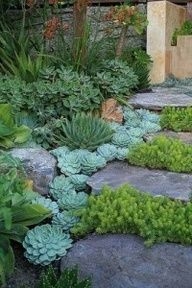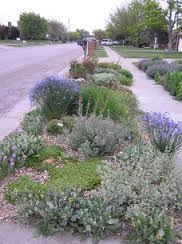Solutions for Drought Gardeners: Hydrozones
How can homeowners drastically reduce irrigation and still maintain a viable and pleasing garden? There are many garden practices that can help conserve and maximize water use. By implementing these, even with less water, plants are able to survive summer heat and drying winds. One effective water management strategy is irrigation by hydrozones.
Start by drawing a plan of your property indicating your trees, shrubs, annuals, lawn, a vegetable garden and other plants. Circle and group plants with similar water needs in hydrozones. Separate hydrozones could include lawn/turfgrass, mass plantings or annual flowers, mass plantings or perennial flowers, non-turf perennial ground covers, and individual trees and shrubs. Not sure of your plants' watering needs? Find out the water requirements of specific plants, by clicking on the link: http://ucanr.edu/sites/WUCOLS/.
Design a system with multiple independent zones so you can schedule irrigation according to each area's watering needs. Use a variety of irrigation methods and convert to drip irrigation where possible. To guide you in adjusting and resetting irrigation controllers as weather and seasons change, use UC's Easy Calculator for estimating water needs. You can also explore that site to find out about ET zone maps (ET refers to evapotranspiration). You'll see that Contra Costa County has 3 zones: 1,8 and 14.
Grouping of plants with similar watering needs could also include plants with similar root depths, plants that prefer shade or full sun, or plants located on a slope. Providing you keep your irrigation systems in good working order and with proper planning, irrigating plants according to hydrozones means plants receive only the quantity of water they need. No wasted water or overwatered plants!
Since it is difficult to maintain large plantings of vegetables and bedding annuals during a drought, consider reducing their size or eliminating them altogether. Doing this would allow water to be directed to more valued or expensive perennial plantings such as fruit trees which are considered a high irrigation priority. Consider reducing your lawn hydrozone area and expand your patio or deck to allow air and water to reach the root zone of trees.
Maximize your water use in all hydrozones by following these beneficial garden practices. Apply 2 to 4 inches of mulch to slow down evaporation, inhibit weeds and keep soil cool. Add organic matter, such as compost to the soil. Water established plants deeply and infrequently. Water slowly and evenly around the drip line of trees using low pressure and applying water to a minimum of four sites around the perimeter. To keep evaporative loss to a minimum, water early in the morning, when the wind is down and temperatures are cool. Keep plants out of the wind. Familiarize yourself with your soil type and water infiltration rate as this will help avoid runoff.
By understanding the water needs of plants, drought gardeners can care for many types of plants, even with reduced irrigation. Grouping plants into hydrozones and watering them according to their needs is a proven effective water management solution.
For more about evapotranspiration, see UC's Evapotranspiration and Plant Water Use










